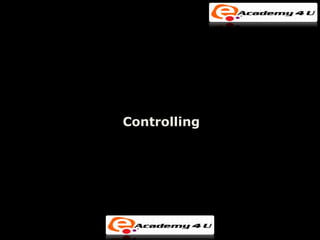
Controlling
- 1. Controlling
- 2. Study Question 1: Why and how do managers control? Controlling – The process of measuring performance and taking action to ensure desired results. – Has a positive and necessary role in the management process. – Ensures that the right things happen, in the right way, at the right time. – Organizational learning and after-action review. 2
- 3. Study Question 1: Why and how do managers control? Feedforward controls – Employed before a work activity begins. – Ensures that: • Objectives are clear. • Proper directions are established. • Right resources are available. – Focuses on quality of resources. 3
- 4. Study Question 1: Why and how do managers control? Concurrent controls – Focus on what happens during work process. – Monitor ongoing operations to make sure they are being done according to plan. – Can reduce waste in unacceptable finished products or services. 4
- 5. Study Question 1: Why and how do managers control? Feedback controls – Take place after work is completed. – Focus on quality of end results. – Provide useful information for improving future operations. 5
- 6. Study Question 1: Why and how do managers control? Internal and external control – Internal control • Allows motivated individuals and groups to exercise self-discipline in fulfilling job expectations. – External control • Occurs through personal supervision and the use of formal administrative systems. 6
- 7. Study Question 1: Why and how do managers control? – Bureaucratic control • influences behavior through authority, policies, procedures, job descriptions, budgets, and day-to-day supervision – Clan control • influences behavior through norms and expectations set by the organizational culture. 7
- 8. Study Question 2: What are the steps in the control process? Steps in the control process: – Step 1 — establish objectives and standards. – Step 2 — measure actual performance. – Step 3 — compare results with objectives and standards. – Step 4 — take corrective action as needed. 8
- 9. Figure 17.3 Four steps in the control process. 9
- 10. Study Question 2: What are the steps in the control process? Step 1 — establishing objectives and standards – Output standards • Measure performance results in terms of quantity, quality, cost, or time. – Input standards • Measure effort in terms of amount of work expended in task performance. 10
- 11. Study Question 2: What are the steps in the control process? Step 2 — measuring actual performance – Goal is accurate measurement of actual performance results and/or performance efforts. – Must identify significant differences between actual results and original plan. – Effective control requires measurement. 11
- 12. Study Question 2: What are the steps in the control process? Step 3 — comparing results with objectives and standards – Need for action reflects the difference between desired performance and actual performance – Comparison methods: • Historical comparison • Relative comparison • Engineering comparison 12
- 13. Study Question 2: What are the steps in the control process? Step 4 — taking corrective action – Taking action when a discrepancy exists between desired and actual performance. – Management by exception • Giving attention to situations showing the greatest need for action. • Types of exceptions – Problem situation – Opportunity situation 13
- 14. Study Question 3: What are the common control systems and techniques? Employee discipline systems – Discipline is the act of influencing behavior through reprimand. – Discipline that is applied fairly, consistently, and systematically provides useful control. 14
- 15. Study Question 3: What are the common control systems and techniques? Employee discipline systems – Progressive discipline ties reprimands to the severity and frequency of the employee’s infractions. – Progressive discipline seeks to achieve compliance with the least extreme reprimand possible. 15
- 16. Study Question 3: What are the common control systems and techniques? Project Management Overall planning, supervision, and control of projects. • Projects – unique one-time events that occur within a defined time period • Gantt chart – graphic display of scheduled tasks required to complete a project • CPM/PERT – combination of the critical path method and program evaluation and review technique 16
- 17. Study Question 3: What are the common control systems and techniques? Economic Value Added – a performance measure of economic value created in respect to profits being higher than the cost of capital Market Value Added – a performance measure of stock market value relative to the cost of capital 17
- 18. Study Question 3: What are the common control systems and techniques? Basic Financial Ratios – Liquidity • The ability to generate cash to pay bills. – Leverage • The ability to earn more in returns than the cost of debt. – Asset management • The ability to use resources efficiently and operate at minimum cost. – Profitability • The ability to earn revenues greater than costs. 18
- 19. Study Question 3: What are the common control systems and techniques? Balanced Scorecard Factors used to develop scorecard goals and measures: – Financial performance – Customer Satisfaction – Internal process improvement – Innovation and learning 19
- 20. Strategic vs Tactical Control Strategic Control Strategic control can be defined as process of monitoring as to whether to various strategies adopted by the organization are helping its internal environment to be matched with the external environment. Tactical Control The detailed and, usually, local direction and control of movements or maneuvers necessary to accomplish missions or tasks assigned. 20
- 21. Comparison between strategic and tactical control Element Tactical Control Strategic Control Time frame Limited Long and unspecific Objective Relate to specific functional Relate to organization as a areas whole Implementation Made within organization Made to other organization Focus Implementation of strategy Determination of overall organizational strategy 21
